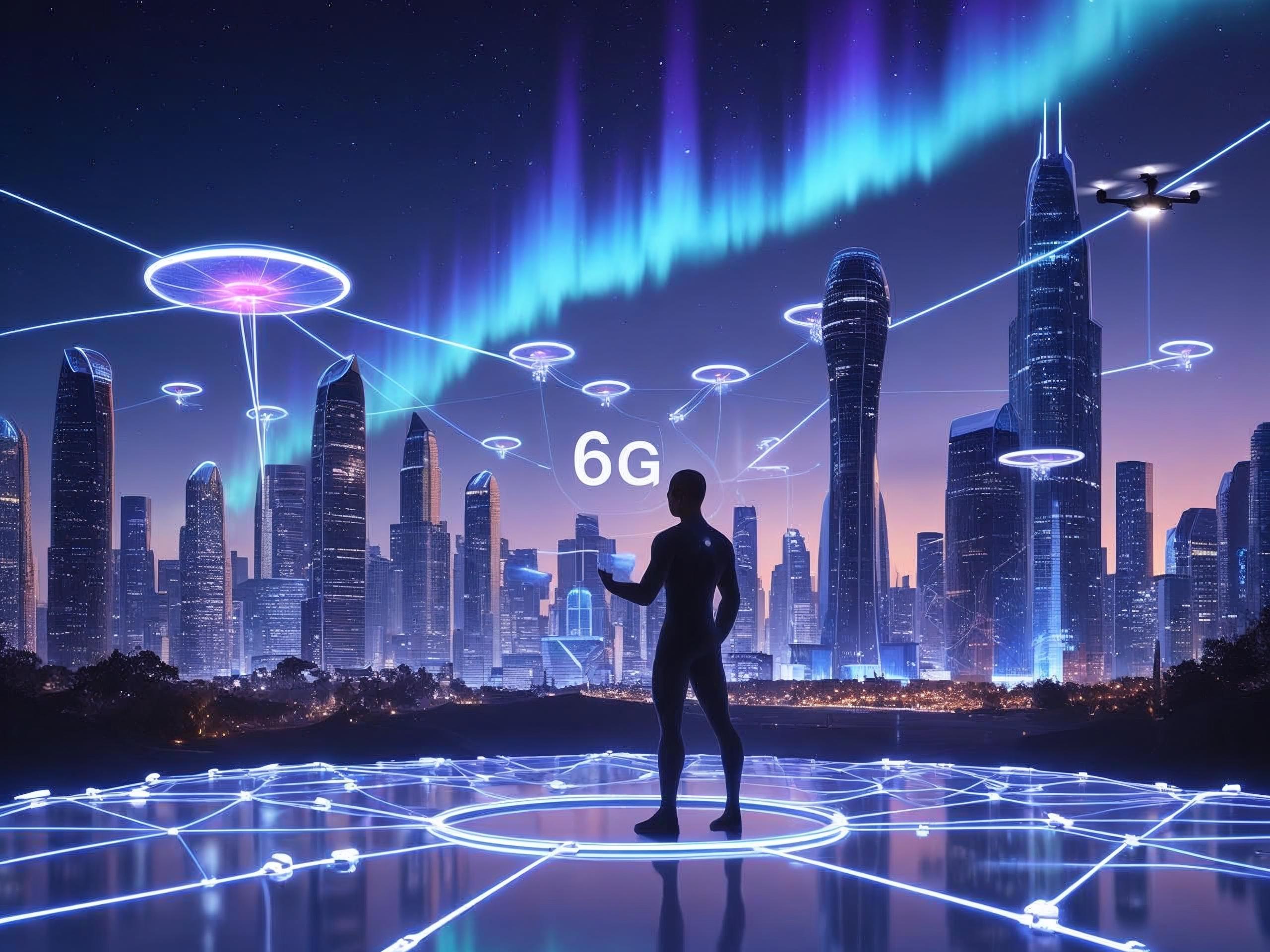Wireless communication has come a long way from the days of 1G analog voice transmission to the advanced digital networks of 5G. As the world continues to embrace digital transformation, there is a growing need for more efficient, faster, and intelligent wireless networks. Enter 6G, the sixth generation of mobile connectivity, poised to revolutionize communication by offering speeds up to 100 times faster than 5G, ultra-low latency, and a level of connectivity that supports futuristic applications like holographic communication, brain-computer interfaces, and autonomous systems.
This blog delves into the world of 6G networks, exploring their architecture, working principles, key technologies, potential applications, and the challenges they face. Our goal is to provide a comprehensive understanding of why 6G is not just an incremental improvement but a foundational shift in the way wireless networks are designed and deployed.
The Evolution of Mobile Networks: From 1G to 6G
To appreciate the significance of 6G, it's essential to understand how mobile networks have evolved over the years:
-
1G (1980s): Analog voice communication with poor quality and no data support.
-
2G (1990s): Digital voice, SMS, and limited data services using GSM and CDMA.
-
3G (2000s): Mobile internet access, video calling, and better data throughput with technologies like UMTS and HSPA.
-
4G (2010s): High-speed internet, HD video streaming, and mobile apps using LTE.
-
5G (2020s): Enhanced mobile broadband, ultra-reliable low-latency communication, and massive machine-type communication.
6G (2030s) will be the next milestone, promising to blend physical, digital, and biological worlds through seamless wireless connectivity.
Defining 6G: What Makes It Unique?
6G is expected to be far more than just faster internet. It will be an intelligent, hyper-connected network that enables a completely new spectrum of services and experiences. Key characteristics include:
-
Ultra-High Speeds: Terabit-per-second (Tbps) data rates.
-
Extremely Low Latency: As low as 0.1 milliseconds.
-
Massive Connectivity: Supporting 10 million devices per square kilometer.
-
AI-Native Architecture: Integrating artificial intelligence into the network core.
-
Enhanced Spectrum Use: Leveraging terahertz (THz) frequencies.
-
Ubiquitous Coverage: Combining terrestrial and non-terrestrial networks.
Core Technologies Behind 6G
The development of 6G will depend on a variety of cutting-edge technologies:
-
Terahertz (THz) Communication
-
Frequencies between 100 GHz and 10 THz offer ultra-fast data rates.
-
Challenges include propagation loss, signal absorption, and hardware limitations.
-
-
Artificial Intelligence and Machine Learning
-
Used for network optimization, traffic prediction, and self-healing networks.
-
Enables cognitive and autonomous network management.
-
-
Reconfigurable Intelligent Surfaces (RIS)
-
Surfaces embedded with smart materials that can reflect, refract, or absorb signals.
-
Enhance signal propagation in complex environments.
-
-
Blockchain and Distributed Ledger Technologies
-
Ensure secure, decentralized data management.
-
Useful for identity management and secure transactions.
-
-
Quantum Communication
-
Offers ultra-secure data transmission based on quantum cryptography.
-
Still in the early stages but highly promising.
-
-
Satellite and High-Altitude Platform Systems (HAPS)
-
Extend coverage to remote and underserved areas.
-
Support global internet and low-latency applications.
-
-
Edge and Fog Computing
-
Reduces latency by processing data near the source.
-
Supports real-time decision-making for critical applications.
-
Network Architecture of 6G
6G architecture will be more complex and intelligent than its predecessors. It will consist of multiple layers and components:
-
Core Network: AI-driven, software-defined, and cloud-native infrastructure.
-
Access Network: Integration of THz spectrum, mmWave, sub-6 GHz, and RIS.
-
Edge Network: Localized processing units for real-time analytics.
-
Non-Terrestrial Network: Satellite and aerial platforms for global coverage.
-
Security Layer: End-to-end encryption, quantum-resistant protocols, and zero-trust models.
Key Applications of 6G
The capabilities of 6G will unlock revolutionary applications:
-
Immersive Extended Reality (XR)
-
Ultra-realistic AR/VR/MR experiences with real-time interaction.
-
Applications in education, entertainment, and virtual workspaces.
-
-
Holographic Communication
-
Real-time holograms for meetings, remote healthcare, and collaboration.
-
-
Brain-Computer Interfaces (BCI)
-
Enable direct communication between the brain and devices.
-
Applications in healthcare, gaming, and accessibility.
-
-
Tactile Internet and Remote Surgery
-
Real-time haptic feedback for remote operations.
-
Precision-critical applications in healthcare and manufacturing.
-
-
Autonomous Vehicles and Smart Cities
-
Real-time communication between vehicles, infrastructure, and control centers.
-
Enhanced traffic management, public safety, and urban planning.
-
-
Global Internet Access
-
Bridging the digital divide with satellite-based 6G coverage.
-
-
Digital Twins
-
Real-time virtual replicas of physical systems.
-
Applications in industrial monitoring, predictive maintenance, and simulation.
-
Challenges and Considerations
Despite its potential, 6G faces several challenges:
-
Technical Challenges: THz signal propagation, energy consumption, and hardware limitations.
-
Standardization: Developing global standards and interoperability.
-
Security and Privacy: Protecting data in a hyper-connected environment.
-
Regulatory Frameworks: Spectrum allocation and international collaboration.
-
Cost and Infrastructure: High deployment costs and need for massive infrastructure upgrades.
-
Environmental Impact: Ensuring sustainable and energy-efficient network operations.
Global Research and Development Initiatives
Countries and organizations are actively investing in 6G research:
-
United States: The Next G Alliance and DARPA's initiatives.
-
Europe: Hexa-X and 6G SNS programs.
-
China: Major 6G research centers and early satellite launches.
-
Japan and South Korea: Leading telecoms working on testbeds and prototypes.
-
India: Bharat 6G Vision and collaborations with global partners.
Academic institutions, industry leaders, and government bodies are collaborating to shape the future of 6G through testbeds, pilot projects, and policy development.
Conclusion: The Road to 6G
6G represents a fundamental leap in wireless communication, driven by the convergence of advanced technologies like AI, THz communication, blockchain, and quantum security. While still in the early stages, its vision promises to redefine how we interact with the digital world.
For businesses, governments, and individuals, understanding 6G is essential to staying ahead in the next era of connectivity. Investments in research, infrastructure, and talent will play a crucial role in making 6G a reality. With careful planning and collaboration, 6G could become the backbone of a smarter, more connected, and inclusive global society.
